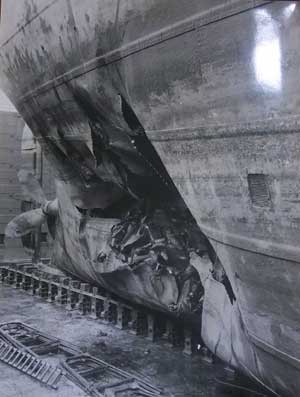| Site Map | Search Warsailors.com | |
|
M/T Spinanger - Damage Report
"As instructed I visited Glasgow on Thursday 23rd instant, to inspect the above vessel which had been damaged by an underwater explosion.
2. On arrival I reported to the F.O.I. C. and was informed by Captain Woolcombe (on F.O.I.C.'s staff) that arrangements had been made for Lt. Cdr. Woodrow to meet me in connection therewith (this officer had visited HMS Thane in connection with an underwater explosion which occurred practically at the same time and in the same place) also that he wished me to report to him before I left. 3. I met Lt. Cdr. Woodrow at the ship and together we viewed the damage. I thought the officer might have been from the D.T.M. Dept. but found he was the bomb disposal officer. He informed me that the damage was very similar to that in the Thane and in a very similiar position. 4. I was also informed that a scientific officer from the Torpedo Factory, Greenock, had visited the ship, but in the absence of any evidence i.e. fragments of weapon etc. no assessment as to the type of weapon was possible. 5. The naval officer informed me that he intended placing 4 of his experienced staff to assist in searching for fragments but after seeing the state of the engine room decided it would be futile to attempt such a search until the broken machinery could be removed. 6. The damage, however, appears to be more consistent with a non-contact weapon than a contact one, and the naval officer who has had a very considerable experience of damage caused by various weapons was of the opinion the damage in both ships was caused by non-contact weapons (possibly by drifting mines which had broken way from their moorings). 7. After my inspection and before I left Glasgow I reported to Captain Woolcombe who informed me that the bomb disposal officer had already given him a similar opinion. Both the F.O.I.C. (Admiral Troupe) and Captain Woolcombe visited the ship whilst in dock. 8. It is understood the damage is not being cut away at present, and a cofferdam is being built on the outside of the shell plating to make the vessel tight, so that she can be taken out of dock by the 28th inst. (as this dock is in great demand being one of the only two docks which can take large ships in the port) and laid up until repairs can be undertaken later. Preliminary Report of Damage 1. M/S Spinanger left Londonderry at 07:45 on the 15th January, 1945, for the Clyde to discharge a cargo of 2100 tons of fuel oil. Degaussing was on. 2. At 09:37 the pilot was disembarked and the ship proceeded, independently, to steering course according to routing instructions. 3. The weather was hazy with a slight westerly wind, and visibility about 1 mile. Sea force 1. 4. The speed of the ship was 12 1/2 knots and the draughts were 10' 3" forward and 20' 0" aft. Mean(?) draught 15' 1 1/2". 5. At 13:40 the weather became clearer, when at 14:05 immediately after having altered course at No. 5 buoy in the swept channel, and in position about 1 mile from the Clyde light ship and on a bearing 040 degrees, an underwater explosion occurred aft, on the starboard side abreast the Engine Room, and in a few minutes the poop was covered in steam. 6. The explosion immobilised the ship and she immediately began to settle by the stern. 7. The steam from both boilers was shut off from the boat deck position and the cofferdam and cargo tanks screwed down. 8. On examination it was found that the engine room was wrecked, the diesel engines being blown over to the port side. The steam dynamos were apparently undamaged but all lighting failed due to the broken steam pipes in the boiler room. 9. The fuel oil cargo was transferred by gravity from Nos. 2 and 7 tanks aft to Nos. 8 and 9 tanks forward to raise the stern of the ship. 10. The draughts after the explosion were forward 6' 0" and aft 30" 0". 11. The ship was taken in tow at 18:15 by HM gatevessel Barfield and towed to Port Bannatyne, Isle of Bute where she arrived at 11:55 on the 16th January, 1945. Structural Damage 13. The tank top and framing in way of the damage was wrecked (no dimensions could be taken owing to the inaccessibility of same). 14. The starboard flat on the starboard side was blown upwards and distorted. 15. The Engine Room casing top was wrecked and the poop deck was blown upwards about 3" on the starboard side around the engine room casing. Note: - No dimensions of plating etc. could be made as this requires a drill test for the same but it appeared to be the usual thicknesses for merchant ship tankers. 16. The cast iron guide channel for the steering quadrant was fractured by shock which rendered the steering gear inoperative. Machinery Damage 18. The steam dynamos on the 2nd platform port side were undamaged apparently. Flooding 20. The engine Room flooded to a depth of 30 ft. and the starboard diesel(?) oil bunker flooded through the after bulkhead which was fractured. Signed, possibly, R. James(?) - date unknown There is also a damage report for HMS Thane, which states in part: "It is (therefore) considered that the damage was caused by a German T.5 torpedo, which has a non-contact pistol, and which would be roaming at a depth of between 30 and 40 feet." - and - further down in the report - "The damage was almost certainly caused by a German T.5 torpedo, with a non-contact pistol, the head containing a 600 lb. charge of alumanized hexanite."
|
